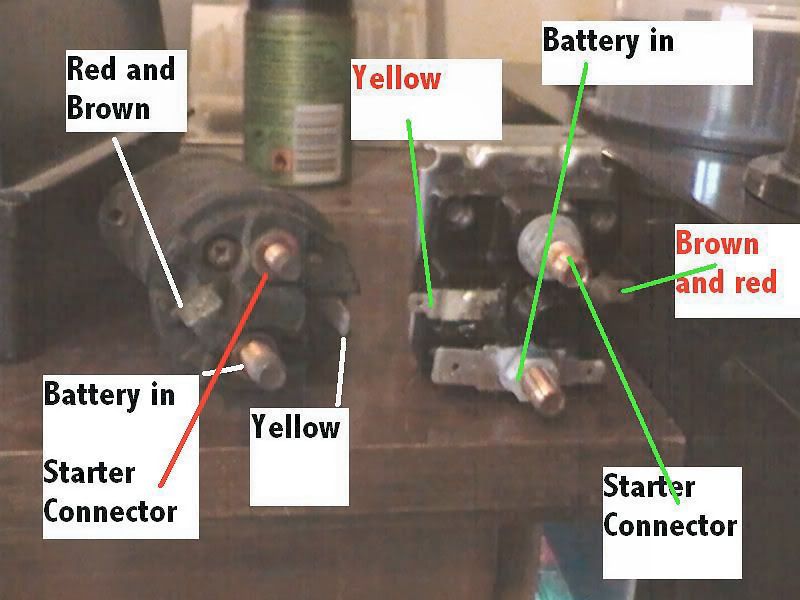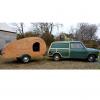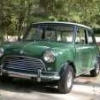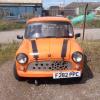
#1

Posted 27 November 2013 - 07:58 PM
#2

Posted 27 November 2013 - 11:41 PM
Let's start with the solenoid.
There are 3- and 4-terminal solenoids. The 3-terminal type is used for standard ignition systems and the 4-terminal type is used with ballast ignition systems.
Looking at your first picture (top down view of the solenoid) the wire from the ignition switch or starter relay will go on the small spade terminal to the left. Depending on the car's wiring and age the wire could be white/red or brown/red. The main battery cable (from the back of the car) goes to the top threaded post. All the brown wires go to the spade terminals that are also on that post. The cable going to the starter motor itself is connected to the bottom threaded post. The mounting foot of the solenoid MUST have a good, clean earth connection to its mounting surface. If the mounting surface does not provide a good earth path, the solenoid will not work.
IF you have a ballast ignition system you need a 4-terminal solenoid. The 4th terminal (a spade lug terminal) will be on the right side of the solenoid. A white/yellow wire goes from that spade terminal to the coil (+) terminal.
IF this were a standard wiring scheme for a standard coil, you would have a white wire coming from the ignition switch going to coil (+). A second wire (white/black) would go from coil (-) to the points in the distributor.
IF this were a ballast ignition system the wiring is a bit different. First you would have the above mentioned white/yellow wire between the 4th solenoid terminal and coil (+). Also on coil (+) would be a pink/white (pink) wire from the ignition switch. As before, a white/black wire would go between coil (-) and the points.
With MOST aftermarket electronic ignitions the wires are red and black. For standard ignition systems, the red wire goes to coil (+) and the black to coil (-). For ballast ignition systems, the black wire still connects to coil (-) but the red wire should be connected to a switched 12V supply such as the fuse box.
Your color codes don't look like what I was expecting so read through my list above for each point to point connection and compare this to what your car has.
#3

Posted 28 November 2013 - 12:25 PM
thanks for that how do I know which threaded post is posotive and negative and does the wire from the ingnition go to the spade connection on the right of the solenoid and not the middle?Let's start with the solenoid.
There are 3- and 4-terminal solenoids. The 3-terminal type is used for standard ignition systems and the 4-terminal type is used with ballast ignition systems.
Looking at your first picture (top down view of the solenoid) the wire from the ignition switch or starter relay will go on the small spade terminal to the left. Depending on the car's wiring and age the wire could be white/red or brown/red. The main battery cable (from the back of the car) goes to the top threaded post. All the brown wires go to the spade terminals that are also on that post. The cable going to the starter motor itself is connected to the bottom threaded post. The mounting foot of the solenoid MUST have a good, clean earth connection to its mounting surface. If the mounting surface does not provide a good earth path, the solenoid will not work.
IF you have a ballast ignition system you need a 4-terminal solenoid. The 4th terminal (a spade lug terminal) will be on the right side of the solenoid. A white/yellow wire goes from that spade terminal to the coil (+) terminal.
IF this were a standard wiring scheme for a standard coil, you would have a white wire coming from the ignition switch going to coil (+). A second wire (white/black) would go from coil (-) to the points in the distributor.
IF this were a ballast ignition system the wiring is a bit different. First you would have the above mentioned white/yellow wire between the 4th solenoid terminal and coil (+). Also on coil (+) would be a pink/white (pink) wire from the ignition switch. As before, a white/black wire would go between coil (-) and the points.
With MOST aftermarket electronic ignitions the wires are red and black. For standard ignition systems, the red wire goes to coil (+) and the black to coil (-). For ballast ignition systems, the black wire still connects to coil (-) but the red wire should be connected to a switched 12V supply such as the fuse box.
Your color codes don't look like what I was expecting so read through my list above for each point to point connection and compare this to what your car has.
#4

Posted 28 November 2013 - 02:29 PM
thanks for that how do I know which threaded post is posotive and negative and does the wire from the ingnition go to the spade connection on the right of the solenoid and not the middle?
The threaded posts are NOT positive or negative as such. If you car is negative earth... then the mounting foot of the solenoid is negative, nothing else. The solenoid is nothing more than a giant relay. It is a switch where one threaded battery cable terminal is "in" from the battery, the other is "out" to the starter motor.
In my first post I identified which Lucas color code wires go where but your wires may not be stock so I also indicated where each wire comes from. The image below was posted by board member "Mars red mike" back in 2010. It should answer your remaining questions. (Obviously you are dealing with the stand-alone solenoid shown on the right).
EDIT: And... the terminal marked brown/red could actually be white/red if you have an early car without the starter relay. It is the wire coming from the start position on the ignition switch.

Edited by dklawson, 28 November 2013 - 02:34 PM.
#5

Posted 28 November 2013 - 02:45 PM
As explained there are no differences in the solenoid posts. It's usual to use the one furthest from the mounting to the inner wing as the battery terminal as it gives more room for the connections to the alternator etc.
Do you mean turning the ignition on - or turning the key all the way to engage the starter makes smoke? You'd need a substantial short to make a battery cable smoke, which would have to be via some much more vulnerable, thinner, wires if it was via the ignition switch. A shorted or stalled starter motor would be more probable if it's with the key all the way.
#6

Posted 28 November 2013 - 07:56 PM
#7

Posted 29 November 2013 - 03:05 AM
As Ethel said, it will take a substantial short for a battery cable to smoke.
Look again at the wiring picture for the solenoid and look at how/where your cables are connected. The main supply from the rear of the car goes to the "top" threaded post on the solenoid, The cable to the starter motor goes to the lower threaded post.
You haven't accidentally connected an earth cable to a threaded post on the solenoid have you?
See the link below for more pictures and a general overview of the starter motor wiring.
http://www.howacarwo...starter-circuit
#8

Posted 29 November 2013 - 11:47 PM
Ok so I was out at the mini there tonite checkin all the wires theres the battery lead that goes to the top threaded post of the solenoid with a few brown wires connected to the post aswel then on the bottom post the one on the inside closest to the wing has the lead going to the starter motor and this is now the one that is smoking and the battery lead is not hot atal. On the coil there is a wire going to + that comes straight from the fuse box and comes out of the top fuse 35amps. And on the - of the coil is a wire connected to the points in the distributor. The coil is getting warm but not producing any spark. I'm lost and havent a clue anyone got any ideas what the problem mite be?As Ethel said, it will take a substantial short for a battery cable to smoke.
Look again at the wiring picture for the solenoid and look at how/where your cables are connected. The main supply from the rear of the car goes to the "top" threaded post on the solenoid, The cable to the starter motor goes to the lower threaded post.
You haven't accidentally connected an earth cable to a threaded post on the solenoid have you?
See the link below for more pictures and a general overview of the starter motor wiring.
http://www.howacarwo...starter-circuit
#9

Posted 29 November 2013 - 11:52 PM
#10

Posted 30 November 2013 - 12:08 AM
it was working before the rebuild but how do I test or know if it is working?Do you know if the starter motor works
#11

Posted 30 November 2013 - 04:07 AM
There are a couple of methods to test starter motors. I assume that since you have the stand-alone solenoid you have an inertia starter so my comments below apply to that type.
First make sure your starter motor is not jammed. The inertia starters have a square drive shaft coming out of the exposed end (pointing towards the distributor). Put a wrench on that and make sure the motor can turn. If it will not turn, place the car in gear and rock the car back and forth then try the wrench again. If the jammed motor can now be turned with a wrench, try the ignition key to see if the motor will turn over properly.
If the starter motor was free to turn when you first tried the wrench, remove the starter motor from the car and take it around to the boot. Connect jumper cables to the car battery and connect the black/ground jumper lead to the starter motor flange. Step on the starter motor (or better yet, have a heavy friend step on it) to hold it to the ground. Touch the clamp on the red battery jumper cable to the big lug on the starter motor where the big cable from the solenoid usually connects. There will be a big spark but if the motor is free and operational, the motor will spin up to speed very quickly. If the motor does not turn or if it is slow or jerky there are problems inside the motor.
EDIT: Sorry... totally overlooked your coil/spark questions. Do not worry about the coil and/or the spark until the starter motor works. Coils do not make sparks until the points inside the distributor open and close. Until you get the engine turning over on the starter... the points aren't going to work so there will be no spark. As for the coil getting hot, if the points happen to be closed the way the engine is sitting, current will flow through the coil 100% of the time the key is in the run position. That will make a coil warm to hot. This is not a problem or something to worry about.
Edited by dklawson, 30 November 2013 - 04:10 AM.
#12

Posted 02 December 2013 - 03:29 PM
ok so I checked everything over the weekend all looked fine and tested my starter motor and it seems to be working fine to but still no spark so I'm gona charge my battery up and see of that makes any difference and also do you know how to check the points in the distributor incase the problem lies there?There are a couple of methods to test starter motors. I assume that since you have the stand-alone solenoid you have an inertia starter so my comments below apply to that type.
First make sure your starter motor is not jammed. The inertia starters have a square drive shaft coming out of the exposed end (pointing towards the distributor). Put a wrench on that and make sure the motor can turn. If it will not turn, place the car in gear and rock the car back and forth then try the wrench again. If the jammed motor can now be turned with a wrench, try the ignition key to see if the motor will turn over properly.
If the starter motor was free to turn when you first tried the wrench, remove the starter motor from the car and take it around to the boot. Connect jumper cables to the car battery and connect the black/ground jumper lead to the starter motor flange. Step on the starter motor (or better yet, have a heavy friend step on it) to hold it to the ground. Touch the clamp on the red battery jumper cable to the big lug on the starter motor where the big cable from the solenoid usually connects. There will be a big spark but if the motor is free and operational, the motor will spin up to speed very quickly. If the motor does not turn or if it is slow or jerky there are problems inside the motor.
EDIT: Sorry... totally overlooked your coil/spark questions. Do not worry about the coil and/or the spark until the starter motor works. Coils do not make sparks until the points inside the distributor open and close. Until you get the engine turning over on the starter... the points aren't going to work so there will be no spark. As for the coil getting hot, if the points happen to be closed the way the engine is sitting, current will flow through the coil 100% of the time the key is in the run position. That will make a coil warm to hot. This is not a problem or something to worry about.
#13

Posted 07 December 2013 - 02:11 PM
Are you saying that the starter motor now works without smoking the cables?
Rather than repeat a lot of information in this thread, please see the page linked below and download my PDF on Lucas Point Ignition Systems. Read it through to get an understanding of how the spark is supposed to be generated.
https://sites.google...wson/home/files
Also tagged with one or more of these keywords: electrical
Mini Technical Sections →
Problems, Questions and Technical →
Broken Headlight Stalk On InnocentiStarted by IceBlue , 25 Aug 2025 |
|

|
||
Mini Technical Sections →
Problems, Questions and Technical →
Econoseal Or Something Else?Started by o0OWILKSO0o , 13 Aug 2025 |
|

|
||
Mini Technical Sections →
Problems, Questions and Technical →
Trying To Find The Right Wire Harness Online...Started by mattaebersold , 22 Jul 2025 |
|
|
||
Mini Technical Sections →
Problems, Questions and Technical →
Mini Rio 93 Boot Wiring IdentificationStarted by KanKanManKan , 11 Jul 2025 |
|
|
||
Mini Technical Sections →
Problems, Questions and Technical →
Rebuilt Engine Wont Crank With CompressionStarted by Kernreuben , 04 Jul 2025 |
|
|
1 user(s) are reading this topic
0 members, 1 guests, 0 anonymous users
















